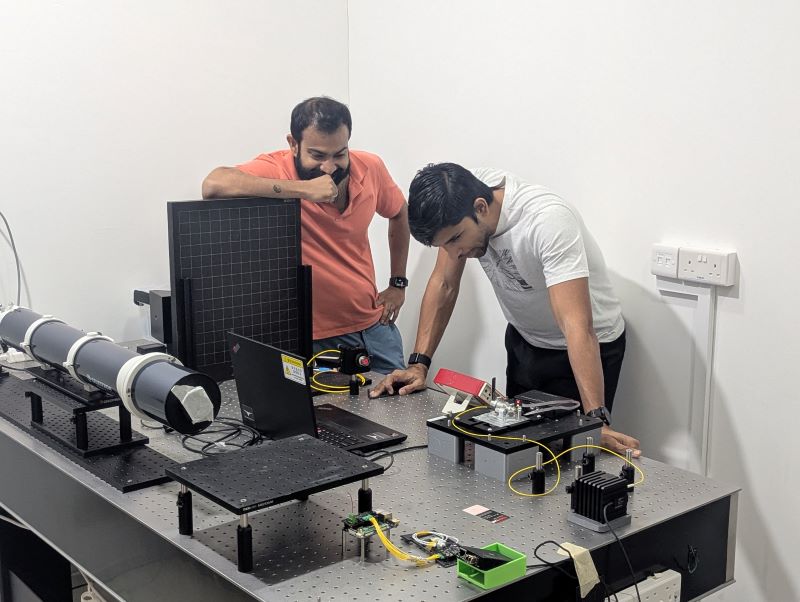From remote villages to the stars: Transcelestial’s lasers power high-speed connectivity where cables don’t go
In an increasingly digital world, access to high-speed internet is no longer a luxury but a necessity. Yet 2.6 billion people1 in the world still lack internet access, missing out on education, jobs and economic opportunities.
Enter Transcelestial, a Singapore-based startup that uses its proprietary wireless laser technology to connect remote, underserved regions without the need for costly optical fibre infrastructure.
Jump to Section: The Challenge | Our Innovation | The Impact

From terrestrial communications, it has diversified and expanded to the realms of space and defence, a feat achieved through A*STAR’s Technology for Enterprise Capability Upgrading (T-Up) programme, which offers access to the skills and expertise of its scientists to support small and medium-sized enterprises in their research and development projects.
The Challenge
Existing internet infrastructure relies on underground or undersea fibre optic cables, which are time-consuming and expensive to build and install. This challenge is especially pronounced in maritime Southeast Asia, a region that comprises more than 25,000 islands, where the digging and laying of cables is impractical and costly.
Meanwhile, terrestrial long-haul networks—an alternative that transmits data over long distances using radio frequency (RF) signals instead of physical cables—are fast approaching its limits. One main issue is interference: multiple telecommunications companies cannot share the same RF spectrum as they will interfere with each other. To avoid this, RF spectrums have to be tightly regulated and licensed, a process that also drives up costs.
Transcelestial was thus founded in 2016 to tackle these challenges. Its first product, CENTAURI, is a wireless terrestrial communications system that sends and receives data through lasers. True to its name, the company’s long-term vision is to build a scalable solution that can venture beyond Earth to outer space. The next hurdle was moving from bench to proof of concept.
Our Innovation
Through the A*STAR T-Up programme, research engineer Thazhe Madam Rohith from A*STAR Singapore Institute of Manufacturing Technology (A*STAR SIMTech) supervised Benjamin Lee, an intern from Singapore Institute of Technology (SIT) in developing in-house precision optics test stations, which are not commercially available, for each component in Transcelestial’s space system. This level of customisation made it possible to test, fine-tune, and optimise each part in order to advance the overall technology and accelerate it going to market.

A*STAR SIMTech research engineer, Thazhe Madam Rohith (left) who was seconded to Transcelestial through the T-Up programme.
The expertise provided by A*STAR contributed to:
- A tenfold reduction in sensor noise by minimising unwanted electrical interference in optical sensors that detect incoming laser signals
- Ultra-precise calibration that is akin to pointing a laser at a coin that is 1,000km away, with up to 50 per cent reduction in calibration time
- Reduced divergence risk by optimising the setup to keep laser beams focused and parallel to each other, minimising signal loss over long distances — crucial for space deployment.
T-Up really allowed us to accelerate and deepen the investigations we were already working on, and it brought the right skills needed to do that. I see it as a multiplier of what the company's already doing.
— Dr Jan Smisek, Head of Space and Defence, Transcelestial
The Impact
Adoption of Transcelestial’s technology has expanded rapidly beyond Singapore to the rest of Asia, including Malaysia, Indonesia, Japan, the Philippines, India and Taiwan.
By 2025, Transcelestial had deployed over 150 laser networks capable of transmitting at least 1.5Tbps (terabits per second; 1Tbps is equivalent to 1000Gbps) of data simultaneously in both directions, making a tangible impact on people’s lives. In the Philippines, for example, Transcelestial partnered with Globe Telecom to overcome geographical barriers and connect underserved regions like Mindanao and Visayas.
Earlier this year, they also announced Singapore’s first inter-satellite laser communications mission, supported by the Singapore Office for Space Technology and Industry and ST Engineering. It is scheduled to be tested in orbit by 2026.
In addition to connecting people, the technology is also reshaping industries.
- High-speed connectivity: It is able to deliver ultra-high speeds of at least 10Gbps (gigabits per second), 100 times faster than the global average broadband speed (megabits per second), allowing for unparalleled communication speeds for improved productivity across all industries.
- Enhanced cost efficiency: Since it is wireless, it eliminates the need for digging and cable installation, significantly lowering total operating costs, and allowing for service in crowded metropolitan cities, regions with difficult terrain and areas prone to natural disasters.
- New frontiers: Its ultra-thin lasers also provide near-zero interference, making it ideal for sensitive fields like national defence and security.
As connectivity challenges persist globally, Transcelestial is targeting new markets where traditional infrastructure falls short, with plans to deepen its engagement with A*STAR beyond the T-Up programme to unlock new possibilities and create lasting impact.
A*STAR celebrates International Women's Day

From groundbreaking discoveries to cutting-edge research, our researchers are empowering the next generation of female science, technology, engineering and mathematics (STEM) leaders.
Get inspired by our #WomeninSTEM







